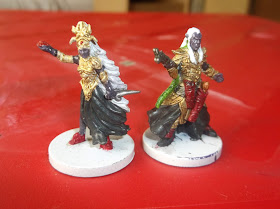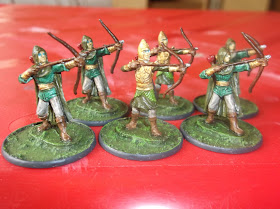A partial explanation of sources, moving roughly from north to south:
- The Black Isle started out as a riff on Naggaroth from WFRP, but ended up morphing into its own thing. Sea dragons and viking vampire cultists and a religion kludged together from the diaspora of a diaspora.
- Vathak is a heavily-altered, massively-condensed version of the continent of the same name from Shadows Over Vathak.
- The northern ice wastes are a combination of stuff from the Pathfinder adventure The Hungry Storm, the crowdsourced hexcrawl the Kraal, this post from Goblin Punch, and... some other blog post that I can't currently find, which had all this great stuff about a haunted frozen city destroyed by ice-storms called down by the slaves of its rulers, mixed in with plenty of original material.
- The Stonemoors were mostly based on the ancient Baltic, but a lot of the things in them were actually inspired by a few questlines and bits of background art in a crappy browser game I briefly played years ago. Funny how things stick with you sometimes.
- The Grey Uplands were mostly based on a zone from the original Sacred computer game.
- The Caves of Purple Lightning are, of course, based on this post from Goblin Punch.
- Ungol is a modified version of Kislev from WFRP 2nd edition.
- Vornheim is, of course, based on Vornheim. Deathfrost Mountain is from Death Frost Doom. The Haunted Highlands are based on the DB series of adventures for Castles and Crusades. The ruined monastery is the one from Horror on the Hill.
- The Plateau of Yeth was based on Minotaurs of the Black Hills from Raging Swan Press, but soon developed into its own thing, with a little help from Scrap and Patrick's reimagining of the Derro in Veins of the Earth.
- Vulture Crag, and the vulture-men in general, are from this Elfmaids and Octopi post. The Pools of Life were mostly based on Dwimmermount. The Pit of Oom is from Petty Gods.
- The Cold Marshes are a combination of elements from lots of different sources, but the Marsh Giants are pretty directly from Pathfinder, and the Witchwood of the Ghost Drummers was mostly inspired by the Grunnheim zone in Torchlight 2.
- I think the Owlmen were inspired by something from Valley of the Hawks by Frog God Games?
- The Cave Dwarves, the Bear Clans, and the Ursine Dunes are all based on things from Slumbering Ursine Dunes. The Isle of the Eld is, obviously, from Misty Isles of the Eld.
- The Relic City-States started out as a riff on some obscure background material from Runescape, of all things, combined with the Scavenger Lands from Exalted first edition. They swiftly became their own thing, though.
- The Plaguelands are mostly based on Ina'oth from Shadows Over Vathak, though the Two Towers are from Towers Two, and the forests north of them were the ones from Sky Ov Crimson Flame.
- The Red Legion - the descendants of the terror-legions of a long-dead demonologist, now the protectors of their people but still wearing their ancestral demon-armour, trying to defend their lands from the undead raised by the necromantic rival of their now-vanished master - grew out of some concepts from the first Spellforce computer game.
- The Yellow Land and the Autocrat's Scar are from The Dread Machine by Gus L.
- The Isle of Xaxus is the one from The Idea From Space.
- Azlant is complicated.
- The Purple Islands are based on The Islands of Purple-Haunted Putrescence, albeit very extensively rewritten.
- The island of the cyclopses was inspired by the Pathfinder adventure module Island of Empty Eyes.
- Zaozerye is based on the medieval Slavic kingdoms. Observatory Lake and its surrounds are from Deep Carbon Observatory. The Tyrant's Maze is loosely based on some bits from Maze of the Blue Medusa. Stonehell, obviously, is from Stonehell.
- Reval was mostly based on medieval Italy. Bright Meadows and its attendant underworld are very loosely based on Liberation of the Demon-Slayer. The Caves of Transformation were based on Madness of the Rat King.
- The Forest of Ruin is inspired by The Dreams of Ruin.
- I think I found the Boar Folk in some OSR bestiary or other?
- Harrowvale is a mash-up of the town from The Haunting of Harrowvale with a few other similar 'spooky little town' settings/adventures. The Cult of Llegh were inspired by the cult of the same name in Petty Gods.
- Ingria was based on early modern Germany. The Order of the Divine Surgeon was a riff on the gloriously obscure and over-complicated backstory of the Order of Leitbur from the earliest years of Magic: the Gathering.
- The Old City is based on 'The City' from Dungeon of Signs, albeit quite a bit smaller.
- Korvosa and Scarwall are mostly from Curse of the Crimson Throne and Curse of the Lady's Light, though Dunnsmouth is from Scenic Dunnsmouth and the Stone Fleet is from Dungeon of Signs.
- Gilan was loosely modelled on the medieval Caucasus Mountains. Aram was sort-of based on medieval Iran. The bat-folk were based on the ones from Elfmaids and Octopi. The House of the Beast is from the Pathfinder adventure of the same name.
- The Thug Bugs are from Fire on the Velvet Horizon. The Blue Cities were inspired by a line in Mutant Crawl Classics. The City of Rot is a mash-up of Skavenblight, the subterranean regions of Ravnica, and The City by James Herbert and Ian Miller.
- Lata was based on northern India and Afghanistan. The Queenscult were from Goblin Punch, but with the Elizabethan aesthetics swapped out for Indian ones. The Land of the Lost is based on World of the Lost, but in an Indian rather than West African context.
- The Shiv and the Forest of Spirits are based on the Pathfinder adventures Souls for the Smuggler's Shiv and Forest of Spirits, respectively.
- Hule is, of course, from X5 Temple of Death.
- Qelong is from Qelong.
- The Jungles of Midnight combine elements from Tomb of Annihilation, the Divine Wight material from Dungeon of Signs, and the Pathfinder adventure path Serpent's Skull.
- Torth is from Revelry in Torth. The Dune Folk were from Exalted. The Shrine of the Eremites was inspired by a monster from the Teratic Tome.
- The Scrap Clans are based on material from the Pathfinder adventure path Iron Gods. The ghoul-queen was originally inspired by the one from Petty Gods, but eventually developed into something very different.
- The City of the Four Voices is based on material from Carcosa.
Not shown here: the island kingdoms of the west and the Lost Lands of the east. They're part of the same world, but I'm saving them for future campaigns.






































